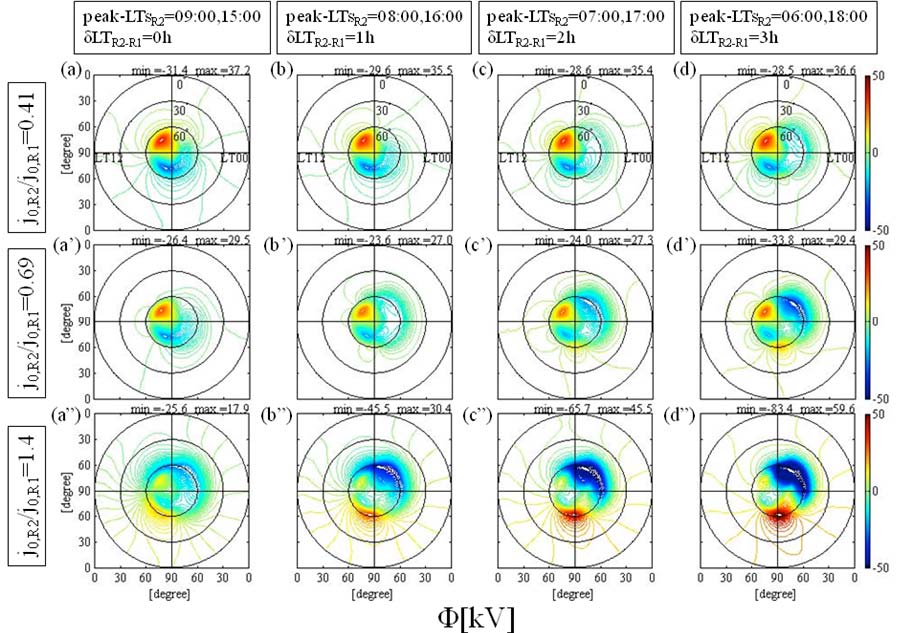GEMSIS-Ionosphere
Overshielding
Ionospheric Electric Field Pattern Controlled by Field-Aligned Currents Deduced by a Global Ionospheric Potential Solver
Using the global ionospheric potential solver GEMSIS-POT, we investigated how the ionospheric electric field changed from an undershielding condition to an overshielding condition as the field-aligned current (FAC) distribution changed. Calculations were performed by changing IR2/IR1, the ratio of current intensities of region 2 (R2) and region 1 (R1) FACs, and by moving the R2-FAC relative to the fixed R1-FAC. The results are summarized as follows.
- With increasing δLTR2-R1 (the local time difference between the R1 and R2-FAC peaks), the efficiency of the shielding by the R2-FAC increased but the associated potential skewed to the nightside.
- The turning point at which the ionosphere transitioned from undershielding to overshielding varied between an IR2/IR1 ratio of 0.7-0.8.
- With increasing δLTR2-R1, the shielding effect weakened around noon, where the R1 potential intruded on the low-latitude region; however, the R2 potential remained dominant at the other local times.
These results suggest that the actual ionosphere cannot be unambiguously classified as either undershielding or overshielding. To describe the ionospheric condition more accurately, we suggest the use of new classification terms, i.e., “complete overshielding” and “incomplete overshielding.” Here, we define complete overshielding as the situation in which the overall ionosphere on the equatorial side of the auroral region is dominated by the R2 electric field, which is the same as the original and strict definition of overshielding. Incomplete overshielding refers to the situation in which the ionosphere is locally but not globally dominated by the R2 electric field. We suggest that overshielding or undershielding identification should be based not only on observations from a limited local time sector, but from the ionosphere as a whole.

The potential pattern variations with IR2/IR1 and peak LTsR2 (the peak local times of R2-FAC). The upper ((a), (b), (c), and (d)), middle ((a′), (b′), (c′), and (d′)), and bottom ((a″), (b″), (c″), and (d″)) rows are the results with IR2/IR1 of 0.5, 1.0, and 1.3. From the most left ((a), (a′), and (a″)) to the most right column ((d), (d′), and (d″)), the peak local times of R2-FAC are moved toward the nightside from 09:00 and 15:00 (equals to that of R1-FAC) to 06:00 and 18:00 (purely dawn and dusk) with an increment of one hour.
Reference: Nakamizo et al., JGR, 2012
Overshielding Electric Fields Associated with Quasi-Periodic DP2 Geomagnetic Fluctuations and Substorms
Based on the magnetometer network and Hokkaido radar data, we deduced that the overshielding electric field plays a significant role in the quasi-periodic (30-60 min) DP2 fluctuation events, which become dominant at the equator when the IMF turns northward. The comprehensive ring current model verified the development of the Region-2 field-aligned currents responsible for the overshielding. Using high-latitude to equatorial magnetometer arrays, we have shown that overshielding occurs at the onset of substorms. Based on global MHD simulations, the cause of the substorm-associated overshielding was confirmed to be the magnetic field dipolarization.
Reference: Kikuchi et al., JGR, 2010
Ionospheric Currents Associated with Overshielding during Storms
Penetration of the magnetospheric electric fields to the equatorial ionosphere was examined using magnetometer data from high to equatorial latitudes for three geomagnetic storms characterized by the equatorial DP2 current during the storm main phase and the counterelectrojet (CEJ) during the storm early recovery phase. The equatorial DP2 started simultaneously with the onset of the ring current, and continued for 2-3 hours during the main phase, indicating instantaneous transmission of the convection electric field to the equator for the period of ring current development. However, the equatorial DP2 decreased in magnitude concurrently with the increase in the auroral electrojet during the late main phase, and changed into the CEJ when the auroral electrojet moved rapidly poleward at the beginning of the recovery phase. It is suggested that the electric field associated with the DP2 current may play a major role in driving the ring current, and that the overshielding responsible for the CEJ contributed to the ring current decay.
Reference: Tsuji et al., JGR, 2012
Equatorial Counterelectrojet Developed at the Onset of the Substorm
The current system that connects the inner magnetosphere and the equatorial ionosphere develops at the onset of the substorm. The overshielding electric field develops during substorms and counterelectrojet flows in the equatorial ionosphere [Kikuchi et al., 2000]. The overshielding becomes dominant because of convection reduction [Kikuchi et al., 2003]. Conversely, it has been reported that the equatorial electrojet increases during substorms because of the increase in the convection electric field [Huang et al., 2004].
- We found that overshielding occurs at the equator when the convection electric field increases at auroral latitudes. Detailed analyses using magnetometer networks and SuperDARN data reveal that for isolated substorms, the Region 2 and Region 1 field-aligned currents develop at the onset of the substorms, leading to a counterelectrojet at the equator and an increase in the convection electric field at high latitudes. We also found that the overshielding begins simultaneously with or earlier than the mid-latitude positive bay at midnight. Consequently, a current circuit is completed between the asymmetric ring current and the equatorial counterelectrojet via the Region 2 field-aligned currents at the onset of the substorms.
- Analyzing isolated substorms with magnetometer-array data and SuperDARN convection maps, we deduced that the overshielding electric field and currents develop at the subauroral-to-equatorial latitudes at the onset of substorms, a few minutes earlier than the formation of the substorm current wedge. The results indicated that both R1- and R2-FACs were generated; however, the R2-FACs were strong enough to produce a reverse current at the subauroral latitude and a counterelectroject (CEJ) at the dayside equator. Thus, we can conclude that the substorms begin with the intensification of the R2-FACs CEJ in the inner magnetosphere.
 Japanese
Japanese